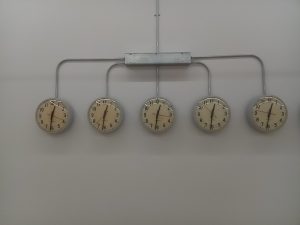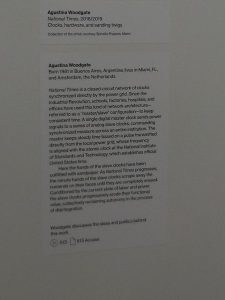The Whitney Museum was founded by Gertrude Vanderbilt Whitney in 1930, opened in 1931, and has lived through many moves until today. In 1932, the Whitney Biennial was introduced to showcase artworks from today. Visiting the Biennial exhibit was an experience I had never thought to have.
One of my favorite (and weirdest) exhibits was “Procession” by Nicole Eisenman, which portrayed a series of statues and monuments that were hindered by some form of limitation but continued moving forward. Whether it was dripping liquids or square wheels, the message shown it that no matter what happens, you have to keep pushing forward.
Another great exhibit was “National Times” by Agustina Woodgate. All of the analog clocks in the room were connected to a digital meter that displayed the correct time and thus sent that information to those clocks. This system was mainly used in schools, hospitals, and offices. As you look around the room, the clocks become less yellowed and more out of sync.
The last exhibit I really enjoyed was Milano Chow’s “Floor Plan I” and Floor Plan II.” The changes in depth and changes in the position of the people in it set an eerie-like tone like that of a video game series that I enjoyed playing: “Rusty Lake.” It also helps up and coming drafters to get an idea of what a more complex draft will look like.
Overall, the Whitney Biennial was a memorable experience and I hope to visit again soon.













